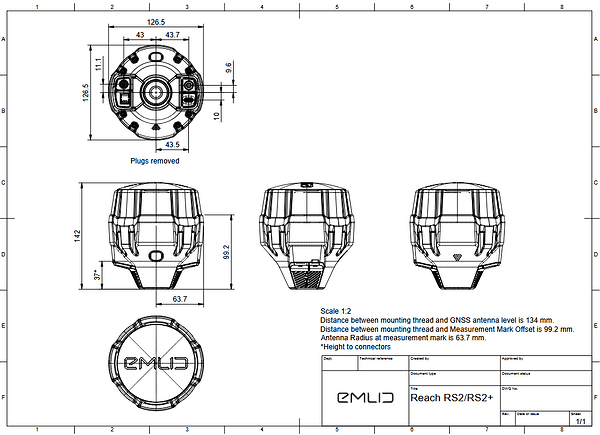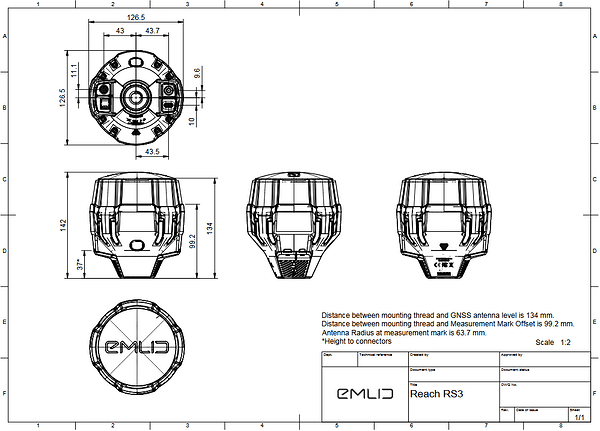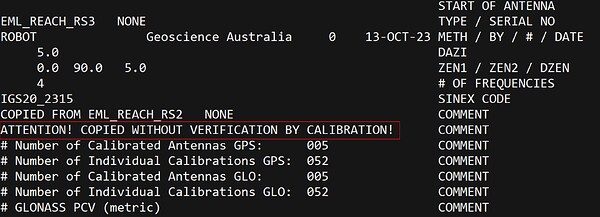Hello to all, so this is the issue: frecuenly some clients that i have ask me for a calibration certificate for my GNSS antennas (rs+ and rs3) like the one u get with a total station. for a total station i get it: a lot of moving parts, a lot of internal measurements that must be in a certain range. for what i undertand inside a GNSS antenna there is no moving parts (except for the imu i guess). the only “calibration” i can think of is a comparison of distances or points between total station vs gnss vs tape measure to “prove” that my rs+ and rs3 are working fine. today i got a mail offering such certificate for gnss. have you ever been asked for something like this?
Yes, regularly. There is a common misinterpretation of the term calibration for GNSS because the same word is used for total stations, which is another tool for surveyors. You described it very well.
Actually, for non-IMU receivers, there still is a moving piece, which is the oscillator of the GNSS chip, used to sync the signals tracking and calibrated at the factory. But this is surely not something you would touch outside a lab and proper equipment ![]()
In my case I just usually did a set of measurements and provide the client with a certificate that the receiver respects its specifications. So, not a calibration, but a certificate.
I think this guy below also provides self-signed “certificates”. Definitely high credibility.
I guess you could provide 2-3 measurements based on some passive reference marks in the area showing the precision and accuracy between your observations and what is on record? Type it up all fancy with elaborate gold foil border. Sign and stamp it?
This might be an interesting topic to understand at what point do you let your unknowns become knowns.
Geoscience Australia, for example, has a GNSS Calibration Service. However, it is basically prioritised for antennas which would then become part of CORS Networks. I would expect something like this would be available elsewhere in the world (the US has one too), but is it really necessary for day to day calibration (per se)?
Geoscience Australia also provides the AUSPOS Service, which has various models of Emlid devices known to offset the ARP when calculating your devices position. This system mentions using the devices specifications from the National Geodetic Survey (NGS) antenna calibration website. Doing some digging here, you will find some calibration information. What is interesting is that when you read the header of the ANTEX File, you will see that the Calibration was done by Geoscience Australia on Line 8 with a method and date. So it seems that Emlid has homologated (hence no serial number in Line 7) the RS2/+, RS3 & RX. It is interesting to note that the IMU is not part of this calibration, only GNSS performance.
I guess the question from here is, what now? Does the device which is doing day to day work actually require calibration again in the future? What would the allowable tolerance be before it’s required or known to be required?
Joel
Some further reading I stumbled across about the test
GNSS Absolute Antenna Calibration at the National Geodetic Survey
RS2 was calibrated, but not RS2+ or RS3. The results have been propagated (cut and pasted) across the other two in the atx file.
And GA’s & IGS interest is the accuracy & precision of static observations.
So for both reasons expected that IMU would not be calibrated.
Discussion here:
Emlid Reach RS2+ / RS3 Antenna Options in Software - Reach RS3 / RTK / PPK configuration - Emlid Community Forum
I know there was another post somewhere that mentioned that mechanically, the type and placement of the antenna is the same between the RS2 and RS2+ (there was only a cellular modem change), so the same must then be true for the RS3 when the UHF and IMU were added.
Clearly that’s the assumption and it was confirmed in the other thread.
Anyone that’s spent time in RF environments would be very wary of the potential impacts of seemingly minor or unconnected changes so I would be careful assuming something “must be true”.
And the question here is in relation to Certificates and so statement in the atx file from the editor who clearly understands propagation nuances:
“ATTENTION! COPIED WITHOUT VERIFICATION BY CALIBRATION!”
would put a big fork through any Legal Traceability.
i agree
i hope this can be “fix” in the future. idk, maybe the calibration lab has to much work, to much paperwork or something like that.
for daily use it seems to me a bit overkill -excuse my words-
The “calibration” service for gnss offered in my area was just another coordinate comparison, data log check and cleanup in general. for now i choose to believe Emlid rs3 “copied calibration” , but ill compare my data any time ill have a “calibrated” gnss in my hands.
i dont think such calibration like for a total stations exist for gnss. ill keep asking anyway.
And with a Comic Sans MS font too ![]()
The “certificate” goes along a report with the method of measurements of course. It certifies that the work has been done following a state-of-the-art method, usually the ISO17123-8 norm.
YES!!!
SEE: The Importance of Obtaining the NGS Calibration Report
If an antenna has been tested for calibration, it will be found here.
https://www.ngs.noaa.gov/ANTCAL/
Might as well include these too to satisfy doubters.
Hi guys,
I can confirm that the antenna’s placement in Reach RS3 remained the same, so the calibration for Reach RS2 and RS2+ is also valid for Reach RS3.
Nevertheless, all receivers undergo a particular testing procedure during production.
This topic was automatically closed 100 days after the last reply. New replies are no longer allowed.







